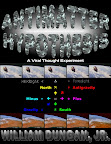Chinese Room Argument
From the outside the Chinese Room passes the Turing Test, in which an outside interrogator cannot distinguish between the hidden occupant of a room being a human or a machine. To perform the test, the outside interrogator, fluent in Chinese, writes messages in Chinese and passes them into the room. Responses, in Chinese, are eventually retrieved from the room which the interrogator evaluates and becomes convinced that the occupant of the room does in fact ‘understand Chinese.’
At this point, Searle asserts the Chinese Room passes the Turing Test. However, unbeknownst to the interrogator, inside the room John Searle himself performs all the work. Searle asserts that he does not understand Chinese. He takes written input from the outside, consults rule books, and uses scratch paper to figure out what actions to perform. The rule books contain a computer listing for an artificial intelligence program. Searle follows the program that culminates with output in Chinese that he sends out of the room.
Now here’s the kicker. Searle asserts that both before and after the exercise he does not ‘understand Chinese,’ and furthermore he asserts that the artificial intelligence program does not understand Chinese either, since he performed all the work inside the room. Therefore, Searle asserts, claims to artificial intelligence are refuted.
Chinese Kitchen Rebuttal
Upon cross examination, let’s get specific and say the Chinese Room in question is a kitchen. The Chinese Room is a Chinese Kitchen in a Chinese Restaurant. To begin with the waiter writes up a customer order, which he passes into the Chinese Kitchen. As stipulated, Searle is in the Chinese Room. He looks at the order and, as stipulated, it’s written in Chinese; but Searle, as stipulated, doesn’t understand Chinese. So, as stipulated, he consults a rule book.
The first rule book he consults is the menu. Every entrée on the menu lists the name of the dish in Chinese, the name in English, and the price. Ignore the price. It’s irrelevant to the cook. Using the menu, he tries to match the Chinese characters on the order with the Chinese dish names on the menu. Even if Searle doesn’t understand Chinese he can distinguish similar character patterns from different character patterns. From the Chinese characters Searle identifies the English dish names.
Just out of curiosity, if who’ve ever eaten at a Chinese restaurant, then have you ever bothered to learn the Chinese characters for the dishes you ordered? Me neither, and we can assume that Searle hasn't either.
At this point, Searle consults another rule book. It’s written in English so he can understand it, as stipulated. The next rule book he consults is a cookbook, from which he prepares the dishes according to recipes he finds by their English names. When Searle is done cooking, he passes the dishes out of the Chinese Kitchen for the waiter to serve to the customer. As stipulated, the output of the Chinese Room is in Chinese, Chinese food in this case.
According to the Turing Test the proof is in the tasting, ‘the customer is always right.’ If Searle performed an accurate impersonation of a competent chef, then most customers will be satisfied that Searle ‘understands Chinese’ in the cooking sense and leave a tip. Otherwise the dishes will be sent back to the kitchen. But according to Searle’s Chinese Room argument we should trust his self-evaluation of his ability to simulate artificial intelligence or in this case a cook. How good a cook John Searle rates himself remains an open question, but should we trust his opinion or the customer’s? That’s debatable. However the following conclusion is irrefutable.
As stipulated, at the end of the experiment, Searle asserts that he does not understand Chinese. Is this true? Let’s find out. So at the end of his shift, Searle exits the kitchen and encounters the waiter who strikes up a conversation in Chinese, but Searle doesn’t understand a word of Chinese. Therefore Searle concludes that he never learns to understand Chinese from his experience in the Chinese Room, which is true with qualifications.
Deaf Chef Clarification
In fact, the way the Chinese Room thought experiment is constructed, Seale never has a chance to understand Chinese any better than a deaf chef. So what does this mean? It means that if you didn’t understand from the beginning that the meaning of the phrase ‘understand Chinese’ in the Chinese Room argument really meant to ‘understand Chinese no better than a deaf chef’, then you either misunderstood or were mislead into misunderstanding the Chinese Room argument. Is that insight clear? The Chinese Room argument depends on an interpretation of the word ‘understand’ that seems familiar. However, once the correct interpretation is exposed through rigorous cross examination, then the Chinese Room argument loses sensibility. That is normally what happens with fallacious rhetorical arguments.We all have a familiar sense of what it means to ‘understand Chinese,’ which involves auditory communication. However, this is incongruent with the best possible outcome of the Chinese Room argument, which is to ‘understand Chinese no better than a deaf chef.’ Agreement with the premise and conclusion of the Chinese Room argument depends upon our sustaining the initial incorrect belief. Once we become aware of this incongruence then the suspension of disbelief bubble bursts.









No comments:
Post a Comment